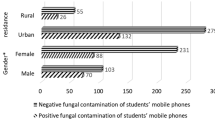Abstract
Objective:
To determine the bacterial contamination rate of the parent’s cell phone and the effectiveness of anti-microbial gel in reducing transmission of bacteria from cell phone to hands.
Methods:
Cross-sectional study of cultures from the cell phone and hands before and after applying anti-microbial gel (n=50).
Results:
All cell phones demonstrated bacterial contamination. Ninety percent had the same bacteria on the cell phone and their cleaned hands. Twenty two percent had no growth on their hands after applying anti-microbial gel after they had the same bacteria on the cell phone and hands. Ninety-two percent of parents were aware that cell phones carried bacteria, but only 38% cleaned their cell phones at least weekly.
Conclusions:
Bacterial contamination of cell phones may serve as vectors for nosocomial infection in the neonatal intensive care unit. Bacteria transmitted from cell phone to hands may not be eliminated using anti-microbial gel. Development of hand hygiene and cell phone cleaning guidelines are needed regarding bedside cell phone use.
This is a preview of subscription content, access via your institution
Access options
Subscribe to this journal
Receive 12 print issues and online access
$259.00 per year
only $21.58 per issue
Buy this article
- Purchase on Springer Link
- Instant access to full article PDF
Prices may be subject to local taxes which are calculated during checkout
Similar content being viewed by others
References
Larson E . A causal link between handwashing and risk of infection? Examination of the evidence. Infect Control 1988; 9: 28–36.
Steere AC, Mallison GF . Handwashing practices for the prevention of nosocomial infections. Ann Intern Med 1975; 83: 683–690.
Garner JS, Favero MS . CDC guidelines for the prevention and control of nosocomial infections. Guideline for handwashing and hospital environmental control, 1985. Supersedes guideline for hospital environmental control published in 1981. Am J Infect Control 1986; 14: 110–129.
Centers for Disease Control and Prevention. Back to basics. 1997 Codes emphasize handwashing. Health Care Food Nutr Focus 1996; 13 (1): 8.
Jeske HC, Tiefenthaler W, Hohlrieder M, Hinterberger G, Benzer A . Bacterial contamination of anaesthetists’ hands by personal mobile phone and fixed phone use in the operating theatre. Anaesthesia 2007; 62: 904–906.
Brady RR, Hunt AC, Visvanathan A, Rodrigues MA, Graham C, Rae C et al. Mobile phone technology and hospitalized patients: a cross-sectional surveillance study of bacterial colonization, and patient opinions and behaviours. Clin Microbiol Infect 2011; 17: 830–835.
Ulger F, Esen S, Dilek A, Yanik K, Gunaydin M, Leblebicioglu H . Are we aware how contaminated our mobile phones with nosocomial pathogens? Ann Clin Microbiol Antimicrob 2009; 8: 7.
Tekerekoglu MS, Duman Y, Serindag A, Cuglan SS, Kaysadu H, Tunc E et al. Do mobile phones of patients, companions and visitors carry multidrug-resistant hospital pathogens? Am J Infect Control 2011; 39: 379–381.
Lemmen SW, Hafner H, Zolldann D, Amedick G, Lutticken R . Comparison of two sampling methods for the detection of Gram-positive and Gram-negative bacteria in the environment: moistened swabs versus Rodac plates. Int J Hyg Environ Health 2001; 203: 245–248.
Pittet D, Allegranzi B, Sax H, Dharan S, Pessoa-Silva CL, Donaldson L et al. Evidence-based model for hand transmission during patient care and the role of improved practices. Lancet Infect Dis 2006; 6: 641–652.
Elkholy M, Ewees IE . Mobile (cellular) phone contamination with nosocomial pathogens in Intensive care units. Med J Cairo Univ 2010; 1–5.
Famurewa OaD OM . Cell phone: a medium of transmission of bacterial pathogens. World Rural Observ 2009; 1: 69–72.
Saiman L . Hospital-acquired infections in the neonatal intensive care unit. Introduction. Semin Perinatol 2002; 26: 313–314.
Boyce JM, Pittet D . Guideline for Hand Hygiene in Health-Care Settings: Recommendations of the Healthcare Infection Control Practices Advisory Committee and the HICPAC/SHEA/APIC/IDSA Hand Hygiene Task Force. Infect Control Hosp Epidemiol 2002; 23: S3–40.
Fendler EJ . The impact of alcohol hand sanitizer use on infection rates in an extended care facility. Am J Infec Cont 2002; 30: 226–233.
Ehrenkranz NJ, Alfonso BC . Failure of bland soap handwash to prevent hand transfer of patient bacteria to urethral catheters. Infect Control Hosp Epidemiol 1991; 12: 654–662.
Pittet D, Allegranzi B, Boyce J . The World Health Organization Guidelines on Hand Hygiene in Health Care and their consensus recommendations. Infect Control Hosp Epidemiol 2009; 30: 611–622.
Acknowledgements
We thank Tina Lopez, RN with the Mednax Center for Research, Education and Quality, for her assistance with the study preparation and navigation through the Swedish Medical Center Institutional Review Board. Glendon Pflugrath, MT(ASCP), technical supervisor in the microbiology department at the Laboratory Corporation of America, for his technical support in the microbiology laboratory. Reese Clark, MD, FAAP with the Mednax Center for Research, Education and Quality, for his kind review of this manuscript. This work was financially supported by Mednax Services, The Mednax Center for Research, Education and Quality.
Author information
Authors and Affiliations
Corresponding author
Ethics declarations
Competing interests
The authors declare no conflict of interest.
Rights and permissions
About this article
Cite this article
Beckstrom, A., Cleman, P., Cassis-Ghavami, F. et al. Surveillance study of bacterial contamination of the parent’s cell phone in the NICU and the effectiveness of an anti-microbial gel in reducing transmission to the hands. J Perinatol 33, 960–963 (2013). https://doi.org/10.1038/jp.2013.108
Received:
Accepted:
Published:
Issue Date:
DOI: https://doi.org/10.1038/jp.2013.108



